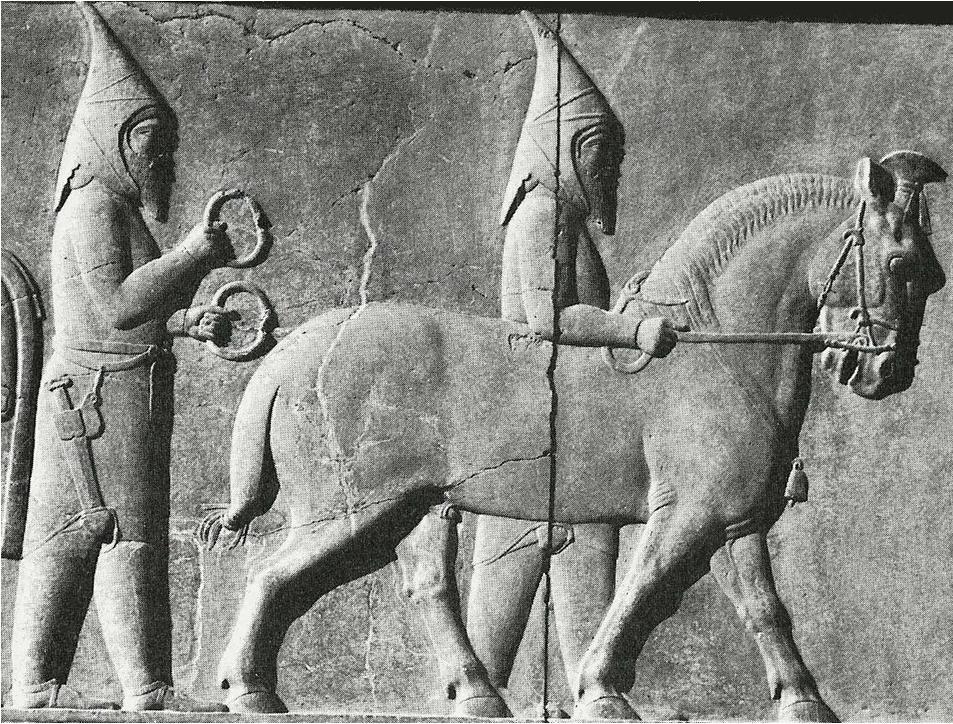The article “The Saka legacy in Ancient Iran” written by Guive Mirfendereski was originally published in Iranian.com on May 24, 2005. The term Saka is often cited as “Scythians” in the west, notably by classical authors in reference to the Iranian-speaking peoples of ancient Eastern Europe.
Guive Mirfendereski is VP and GC at Virtual Telemetry Corporation since 2004 and is the artisan doing business as Guy vanDeresk (trapworks.com). Born in Tehran in 1952, he is a graduate of Georgetown University’s College of Arts and Sciences (BA), Tufts University’s Fletcher School (PhD, MALD, MA) and Boston College Law School (JD). He is the author of A Diplomatic History of the Caspian Sea (2001).
Kindly note that the images and accompanying captions printed below do not appear in the original article by Guive Mirfendereski.
Readers further interested in these topics are encouraged t0 consult the following sources:
=====================================================================================
In a number of recent articles I have alluded to the Saka, a grouping of Iranian-speaking horsemen who entered the west-central regions of present-day Iran and eventually became a part of the list of nations that made up the Achaemenian Empires [“Of wine and war“, “Homavarka“]. In this essay, I explore the influence of Saka on such place-names as Sakkiz, Sakastan, Sakavand and Arsaka.
To get us to the discussion of the place-names, I will first describe in general terms the place of the Saka in ancient Iranian. Theirs is a fascinating story of a people who, not unlike many others came before and after them, began with a tumultuous arrival on the Iranian plateau as invaders, followed by them being booted out and only to return later and become as one of “us.” Whatever this “us” has been in different times of Iranian history shall be the subject of a future essay. For now, to learn more about Saka, I refer you to the Old Persian texts, with transliteration and translation, on the website Avesta.org, for the picture of Achaemenian monuments depicting them please refer to the website of the Oriental Institute (University of Chicago).
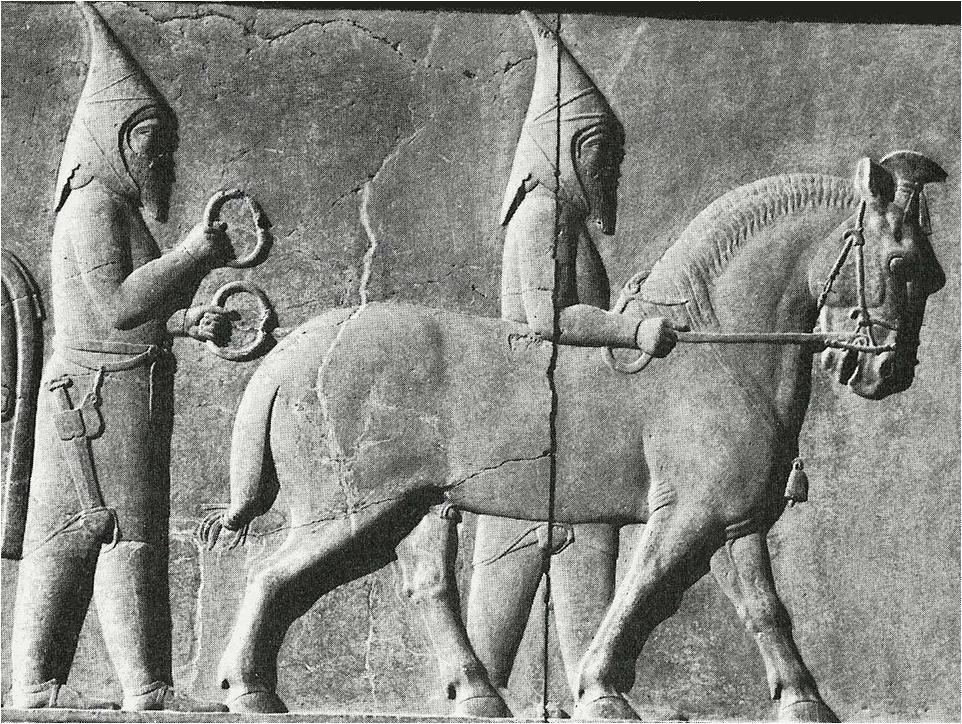
Saka Tigra-khauda (Old Persian: pointed-hat Saka/Scythians) as depicted in the ancient Achaemenid city-palace of Persepolis. It was northern Iranian peoples such as the Sakas (Scythians) and their successors, the Sarmatians and Alans, who were to be the cultural link between Iran and ancient Europe (Picture used in Kaveh Farrokh’s lectures at the University of British Columbia’s Continuing Studies Division and Stanford University’s WAIS 2006 Critical World Problems Conference Presentations on July 30-31, 2006).
For traditional written works on the Saka, I recommend Herodotus’ “Histories” (Rawlinson’s edition), Roman Ghirshman, “Iran” (1954), J. M. Cook’s “The Rise of the Achaemenids and Establishment of their Empire,” in Cambridge History of Iran (vol. 2) and two general works by Tamara Talbot Rice — “The Scythians” (London, 1957) and “Scythians,” in the 15th edition of Encyclopaedia Britannica (1981). There is also H.W. Bailey’s “Khotanese Saka Literature,” in Cambridge History of Iran (vol. 3:2); T. Sulimirski’s “The Scyths” in Cambridge History of Iran (vol. 2) and Mallory and Mair, “The Tarim Mummies.” For a comparative linguistic look at the various names that applied to Saka see the essay by Oswald Szemerenyi called “Four Old Iranian Ethnic Names: Scythian — Skudra — Sogdian — Saka” published by the Austrian Academy of Sciences in 1980.
The Iranian-speaking Central Asiatic horsemen who stormed the Median Kingdom from southern Russia in the 7th century were known to the Achaemenians as the Saka. The inscriptions of Darius I the Great at Bisotun, Susa, Parsa (Persepolis) and Egypt, as well as the records of other Achaemenian kings, provide a rich textual and graphic depiction of the people who counted perhaps more than any other group in multiple satrapies of the world’s first and only two world empires — the second arguably being Alexander the Great’s. The tall pointed caps that the Saka donned set them distinctly apart from all others in the realm.
In 6th century BC the Medes expelled the Saka from west-central Iran and the Saka retreated into Armenia while another group of them ended up on the eastern shores of the Caspian Sea, where they intermingled with their Daha kinsmen. Another group pushed east and then south into east-central region of present-day Iran and southern Afghanistan (Zrangiana=Sistan) where they were settled by the dawn of the Achaemenian times.
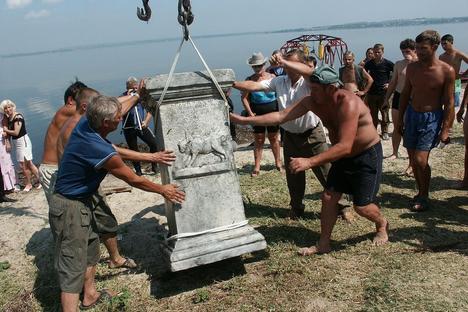
The stele of Darius I being excavated by Russian archeologists in southern Russia (Image Source: RBTH & Press Photo).
The Saka who remained in Media became a part of the kingdom and in Achaemenian times their lands in Jaxartes River (Syr Darya) basin and in the Balkans belonged to the empire, while contingents of them were deployed in Egypt. They were among the few national delegates that bore arms when in the presence of the king and were along with Persians and Medes the backbone of the foot soldiers transported by Xerxes’ ships to fight against the Greeks in the Battle of Salamis.
In 330 BC Alexander III of Macedonia ended the Achaemenian Empire. In the course of the Greek pacification of Iran’s eastern provinces, the Saka made common cause with some Bactrians (Balkhi) and Sogdians in opposing Alexander. Alexander hurried to Jaxartes where, with the use of catapults, he overcame the Saka on the north bank of the river and chased them further inland. In 328 BC Alexander defeated the Bactro-Sogdian allies, married the rebel leader’s daughter, installed a garrison of 10,000 infantry and 3,500 cavalry in Bactria and headed south into India.
The gradual demise of the Seleucid Kingdom (312-64 BC) and concomitant rise of the Parthian kingdom in Iran (247 BC — AD 224) heralded the emergence of the Saka to national prominence as a part of the Parthian tribal blend under Parni (Aparni) leadership. By one account, the Parni were a tribe of Central Asiatic roots, who followed the road along the upper Atrak River and ended up in Parthava [Parthia, greater Khorasan] during the reigns of Seleucid I (312-281 BC) and Antiochus I Soter (281-261 BC). Mixed with the Parni were the Saka, who probably played an important role in the acceptance of the Parni as confederates by Daha. By another account, the Parni were not a separate tribe but the young men of the Saka, who held sway over an area from eastern Caspian to Central Asia.
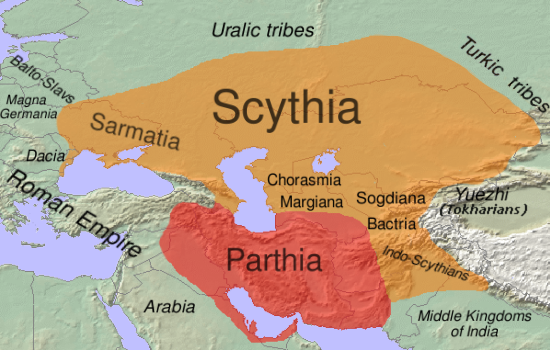
The realms of two Iranian confederations in c. 100 BCE: the Saka or Scythians and the Parthian Empire (Source: Public Domain).
In 247 BC, Arsaces (ruled about 250-211 BC) and his Parni followers took over Parthava and broke away from Seleucid rule. He annexed Hyrcania [Mazandaran and Astarabad] and crowned himself king in the city of Asaak. When Seleucus II (ruled 246-226 BC) reached the breakaway province, in 232 BC, Arsaces fled north to the land of his allies Apasiacae [= Saka of the Waters]. Arsaces accepted Seleucus’ suzerainty and this latter returned to Syria. Under Arsaces’ successor, Artabanus I (aka Arsaces II, ruled about 211-191 BC) Parthia rebelled again and another Seleucid expedition hurried east and forced the Parthian leader to escape to Central Asia until a compromise could be reached with the Seleucids.
During the reign of Mithradates I’s reign (171- 138 BC), the Parthian rule extended ever westward to include Media and the lands bordering the Tigris. With Ekbatana as its capital, the Parthian Empire of Iran now was elbow-to-elbow with the Seleucid kingdom in Syria. By the end of Mithradates’ reign the tribal disturbances in Central Asia resulted in the dislocation of a group of Saka from their traditional grazing grounds, which forced them into southwest China, present-day Sinkiang and Kashgar regions. There, the Saka established a kingdom at Khotan and began pressing up against Parthia’s eastern frontier.
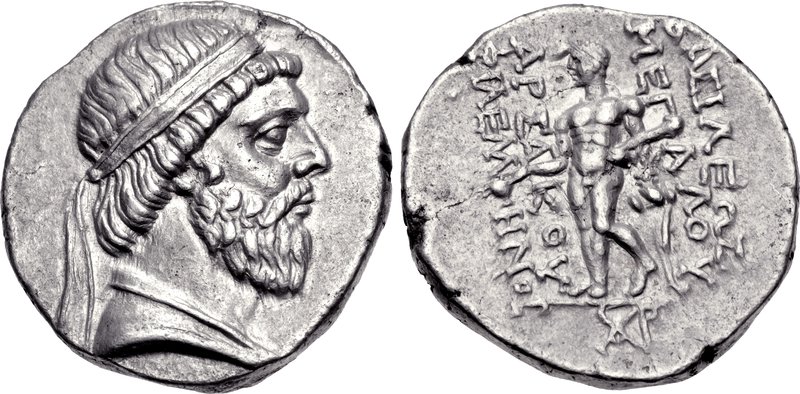
Coin of bearded Parthian monarch: the Classical Numismatic Group, Inc. and Wikipedia cite the coin as depicting Mithridates I (165-132 BCE). However as noted by Kostas Kokkoras (Κώστας Κόκκορας) the Greek inscription reads “ΒΑΣΙΛΕΩΣ ΜΕΓΑΛΟΥ ΑΡΣΑΚΟΥ ΦΙΛΕΛΛΗΝΟΣ” which translates to “Of great king Arsaces the Philhellene”.
During the reign of Pharaates II (139-128 BC), the Persians assisted the Seleucids in dealing a blow to the Parthians in western Iran, but in 128 BC Pharaates, aided by the Medians, gained the upper hand and defeated the Seleucid king, no thanks to the Saka who managed to join his campaign with too little and too late. Pharaates dismissed the unreliable Saka and this provoked a Saka revolt that consumed the countryside and cost Pharaates his life. His successor, Artabanus II (ruled 128-123 BC) did not fair any better.
Mithradates II (ruled 123-88 BC) regained control of Parthia’s eastern provinces, but in the process the Saka retreated eastward into Zrangiana [Drangiana, later Sistan] and further south into India. Between the 1st centuries BC and AD, the Saka settled in Zrangiana and in the aftermath of this migration the place acquired the name Sakastan [country of Saka]. Another Saka group that had been dislocated from Central Asia passed the Pamir Mountains into India, advanced to the western bank of the Indus River and established a kingdom in northwest India by the 1st century AD.
The Parthian kingship under Artabanus III (aka Ardaban, ruled about AD 12 — about 38) repaired its relations with the Saka. Artabanus wanted his son to be elevated to the throne of Armenia, but the Romans were backing a rival claimant. Under Roman attack, Artabanus escaped from his capital and hurried east to take refuge with the Daha; they helped him regain his throne. Subsequently, in the war of succession that ensued between Artabanus’ sons, Hyrcanian and Daha reinforcements helped secure the throne for Gotarzes II (aka Godarz, ruled about 38 — 51 AD). In 58 AD, however, Hyrcania threw off allegiance to the Parthian kingdom and thereafter the Daha and Saka played no noteworthy role in the affairs of the Parthian state.
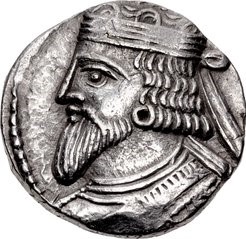
Coin of Parthian king Artabanus III (r. 79/80-81 BCE) minted in Seleucia city (Source: Public Domain and CNG).
I began with this long description of the Saka to support the point that Saka were present on the Iranians scene for a long time and they were spread all over the place. And so, I posit, this significant presence in ancient Iran must have left some imprint on place-names in Iran, especially where Saka’s geographical concentration is known to have occurred the most — principally in Iran’s west-central region, corresponding to the area of present-day Kordestan-Kermanshahan-Lorestan; north-central, corresponding with the east and southeast of the Caspian region; and east-central, corresponding to Sistan and Hilmand basin in present-day Iran and Afghanistan.
The late archeologist and Iranist Roman Ghirshman believed that the Saka who stormed the Median Kingdom in the 7th century BC were settled in an area south of Lake Urumia in a place presently known as Sakkiz, which Ghirshman identified as their capital and in which name:
“… we may recognize the name of the Scythians, or Saka as they called themselves.”
This nomenclature was due, according to Ghirshman, because:
“… the name of a people was often given to its capital.”
Ghirshman believed also that Sakkiz was one of the few villages of Kurdistan that had preserved its name from the time of the arrival of the Saka. Whether that was indeed the case, I cannot say with certainty. Naturally, say “sakkiz,” “saqqiz” or “saghiz” and an Iranian’s ears perk up because the sound conjures up gum, such as chewing gum, and also reminds one of a kind of wood. But etymologically, from a present-day perspective, who could argue with Sakkiz meaning the land of Saka, in which “kiz” referred to the quality of the land that gave rise to them. According to Dehkhoda (vol. 21, pp. 1003-1004) the word “kiz” was already in existence in the 10th century as a noun and place-name suffix. But in antiquity?
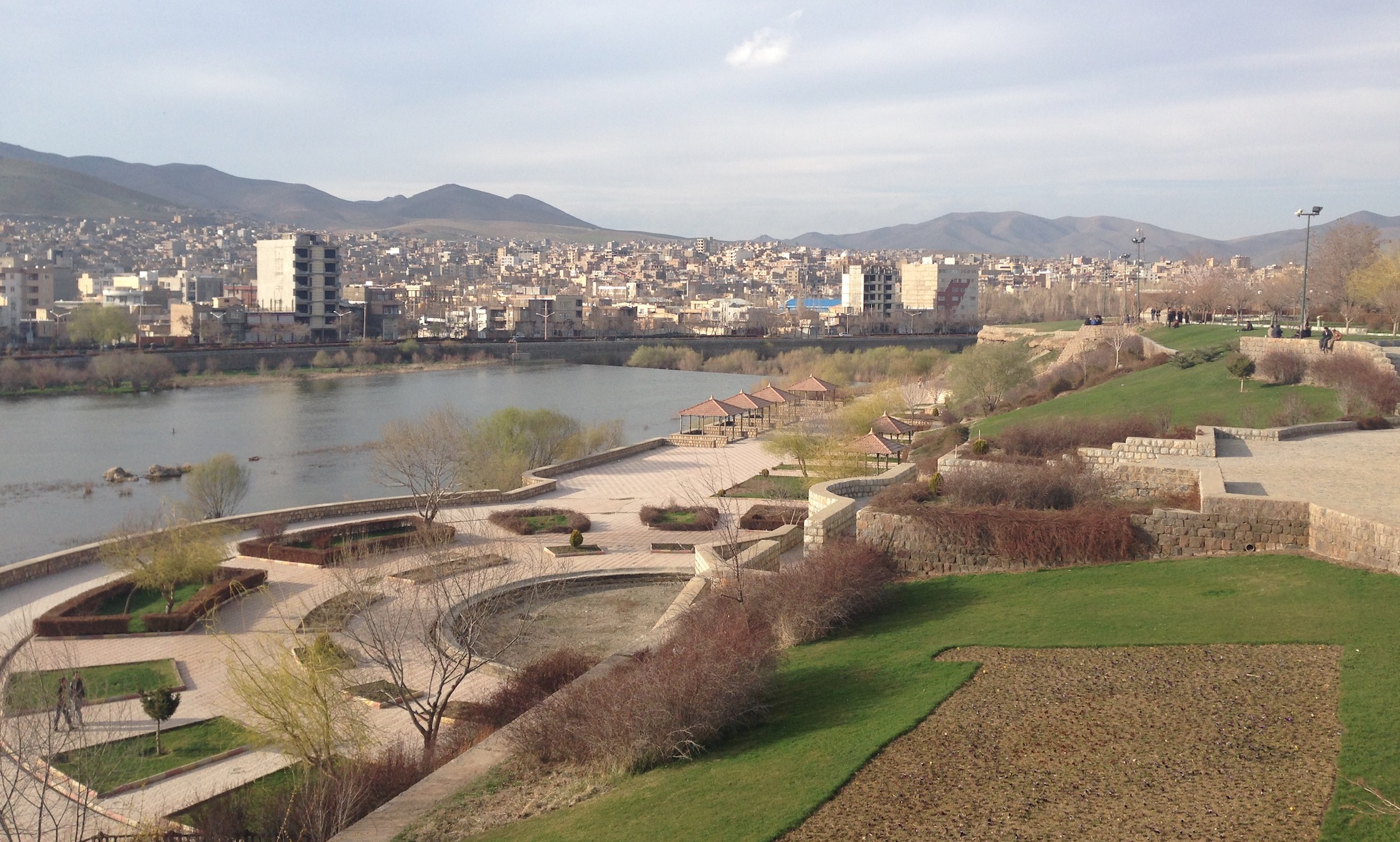
A view of the city of Saqqez (سقز) in the Kurdistan province in western Iran (Photo: Public Domain).
Whether Sakkiz was named such and kept its name from its Saka days are matters of conjecture. It is likely that the name originated with the Saka, but changed and then resurfaced at a later date for a reason altogether different. In the geographical work of the Greek historian Strabo (d. after 23 AD) no mention is made of Sakkiz per se, but reference is made (16.1.18) to a small country named Sagapeni, which was bound in the north by Media and Armenia, in the west by Adiabene and Mesopotamia and in the northwest by Babylon. The name [Sagapeni/Sakapeni] and the description of its geographical situation approximated the location of present-day Sakkiz.
Unlike Sakkiz, Sakastana is the most clearly identifiable of Saka place-names. This designation arose from the fact of Saka’s migration in large numbers into the greater Sistan region. By the time of the Greek itinerant Idirous of Charax Spasini (about late 1st century AD) the place was already called Sakastan, a toponym that would persist as long as the Saka enjoyed regional prominence. With the passing of Sakastan to Sassanian rule about 224 AD, the place-name changed to Sagastan. When the Sasanian ruler Bahram II (Varahran: ruled 276-293 AD) re-conquered the region, he appointed his son, the future Bahram III (ruled 293 AD) as governor and bestowed on him the title of Saganshah (king of the Saga/Saka]. Subsequently, the Arab conquest of Sagastan in 643-44 AD and re-conquest in 650-51 paved the way for the name change to Sajistan, Seijistan, Seistan and Sistan.
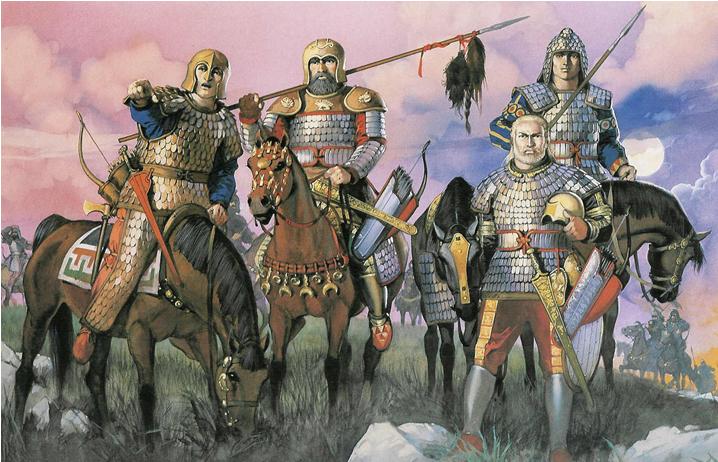
Scythians or Saka Paradraya (Iranian: Saka/Scythians beyond the sea) on the steppes of the ancient Ukraine (Painting by Angus McBride). Scholars are virtually unanimous that the Scythians/Saka were an Iranian people related to the Medes, Persians, Parthians, etc. of ancient Iran or Persia. A branch of the Scythians or Saka were to also settle in ancient northwest India to become later known as the “Sikhs” of the Punjab (Iranian: Punj/panj [five], ab [water, waterway]).
There is an anecdotal connection between Sakkiz and Sakastan and it comes from the meaning of the word “sakkiz” in Persian, terebinth. This small tree native to Northern Africa, Southern Europe and Western Asia is a source of turpentine and also is considered a common object of veneration. In Iran, it is most prominently obtained in the forests of Kordestan, particularly in Pusht Kuh, a mountainous region east of Kermanshah in Lor country. The etymological assumption has been that the word is of Turkic origin (see Dehkhoda, 29:545). This in turn raises the intriguing connection of the plant to Central Asia, the cradle of Turkic languages, and by this association with the Saka and Sakastan (Sistan), who were however geographically from Central Asia but linguistically Iranian-speaking.
In the English translation of Joseph Ferrier’s “Caravan Journeys and Wanderings in Persia, Afghanistan, Turkistan, and Baloochistan,” one reads of one Kazi Mohammad Hassan, a 19th century magistrate of Heart, why Sistan is called by that name. The name, Kazi Mohammad said, derived from the “word ‘saghis,’ the name of a wood much used in Persia for burning at this time.” The wood, Ferrier added, was found frequently in the steppes of Central Asia and grew:
“… in much greater quantities near the Helmund and it is this that has given to the country in which it grows so abundantly the appellation Saghistan, the place of saghis.”
In an amusing comment, the English editor of Ferrier’s work, H.D. Seymour, expounded:
“The Kazi had not heard of the Sakae and their migrations [into Drangiana=Sistan].”
Neither Seymour nor the Kazi would have known for sure about the Saka’s presence in Sakkiz, because the discovery by Ghirshman that made the connection did not come around until the 1950s. Yet, somehow I get the feeling that the Kazi knew more than believed.
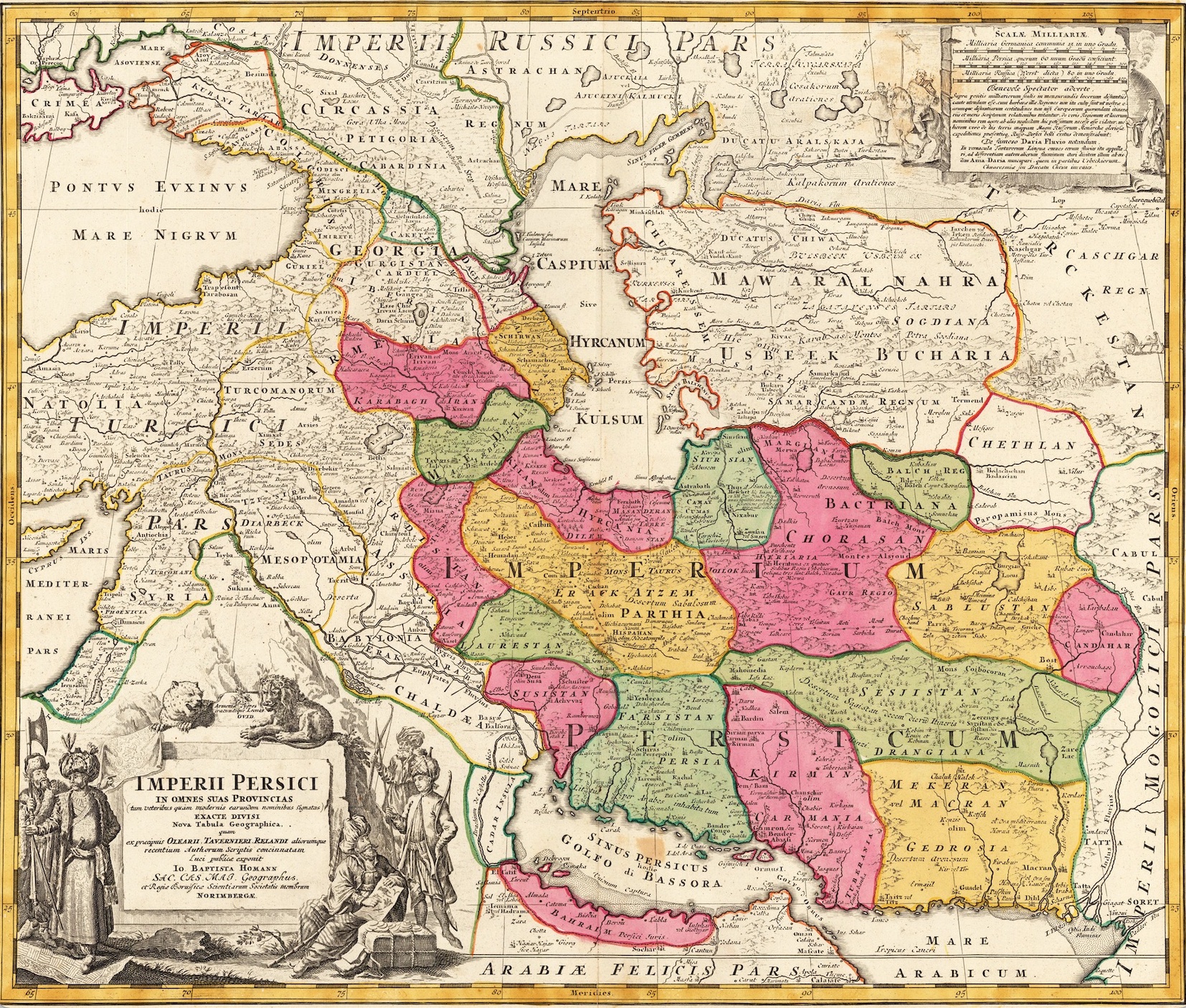
Map of Iran (identified as Imperii Persici or the Persian Empire) drafted by Johann Homann (1664-1724) sometime in 1700-1724 during the latter years of the Safavid dynasty (1732–1736). Seistan is evident above Makran and Kerman (see southeast region in map). Note that the Iranian realms included several countries that were formed as a result of Imperial British geopolitical machinations, notably Pakistan, Afghanistan and Bahrain. Note that southern Caucasus was also a part of Iran but were forcibly ceded to imperial Russia in the early 19th century. The territory known as the “Republic of Azerbaijan” was not known as “Azerbaijan” but as Shirvan, Shamakhie and Albania (Iranians also referred to the region as Arran) – the term “Azerbaijan” is historically attested to the region of northwest Iran. Iranian realms also included territories in what is known today as Central Asia.
The preponderance of the Saka in Sakastan, naturally, would explain the origin and meaning of the place-name Sakavand (variation: Sagavand). In the 10th century Sistan, Sagavand referred to a town at the foot of a mountain of the same name, with a fortified wall and much agriculture. On the other hand, Abulfeda (d. 1331) wrote the name as Sakavand and placed it in the Bamiyan region of Zabolestan. Further Similarly, the place-name Sokavand referred to a fort and village near Ghazneh in the eastern part of present-day Afghanistan.
The connection between the Saka and the place-names Sakiz and Sakastan at two opposite ends of Iran suggests the likelihood of the existence of other Saka place names in the areas where the Saka are known to have inhabited. In the southeast Caspian region, the evidence of a Saka place-name appears in the name Asaak (variation: Asaac, Arsace, Arsacia), which was the early Parthian capital built by Arsaces in about 250 BC. The Orientalist W. Schoff, among others, identified the town as the present-day Quchan, located in the upper Atrak River valley eighty miles northwest of Mashad. The topography of Quchan is highly mountainous, with the nearby Hezarmasjid, Aladagh, and Shahjahan elevations ensuring wintry conditions that last for six months.
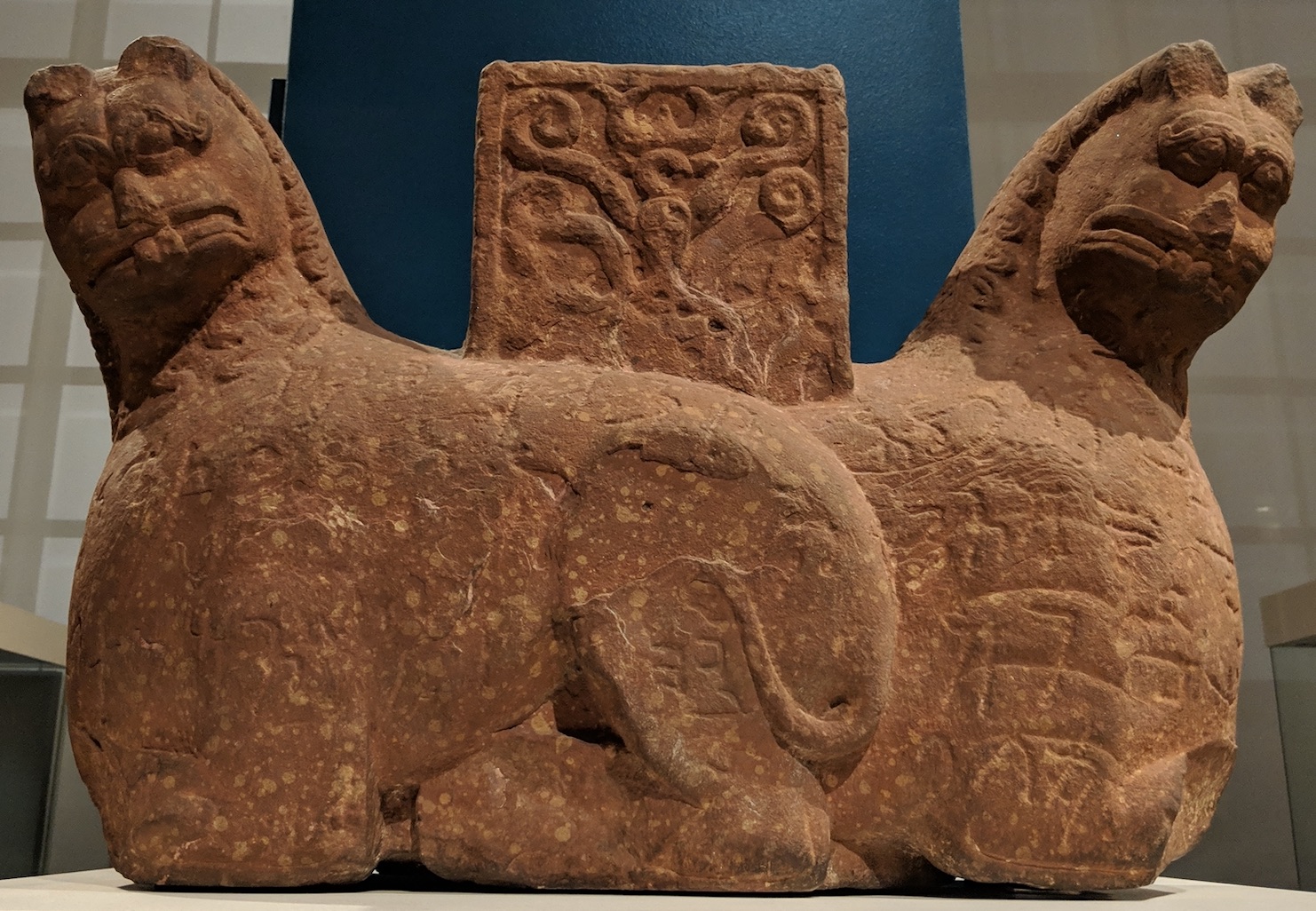
The Indian-Saka sandstone capital known as “the Mathura lion” presented at the British Museum (Source: Sushma Jansari in Public Domain). Notable in the Mathura lion is an inscribed word that reportedly reads “Sakastanasa”.
The name Arsaka was probably a from of Ark+saka that would have meant “the fort of Saka.” The Persian word “ark” meant “fort.” Its variant “arg” meant a small fort built inside another, fort, walled fortification and in Sasanian times “Arkbod” meant commander of the fort. The name Ark (Arg) occurred as a toponym referring to a fort in Sistan (Dehkhoda, 5:1875-76, 1880). Regardless of the form or orthography, the significance of the name “Asaak” itself was in revealing that, unlike in Sakiz and Sakastan, the marker “sak” could serve as an adjectival suffix. Similarly, the notion of a ‘fort’ or ‘fortress’ was evident in the description of the place name Arsakavan [?Ark+sakavan], located south of Ararat Mountain, which served as the seat of an Armenian king named Arsaces II in 4th century AD (see N. Pigulevskaja’s “Cities of Iran in Parthian and Sasanian Eras”).
Lastly, I offer this explanation about the origin of Zadrakarta (a Greek name) and what possible influence the Saka may have had on its development. This was the capital of Hyrcania (Mazandaran and Astarabad) in Achaemenian times and it was where the governor of Hyrcania-Parthia tendered his submission to Alexander. It is identified with present-day area of Gorgan. Phonetically at least, in the name one could hear the echo of the proto-toponym Saka-karta [= village of Saka], where “karta” in Old Persian of the Achaemenians meant “village.” I would go even further to entertain the notion that the word place-name was probably Sakarta, made up of “sa,” which I have equated with “pasture” or “grassland” in Avestan/Old Persian. That a city could be called “Sa-karta” is not far-flung — do you know the way to Sabzevar? Can it then be that people who hailed from Sakarta came to be known to the Achaemenians as Saka, for short?
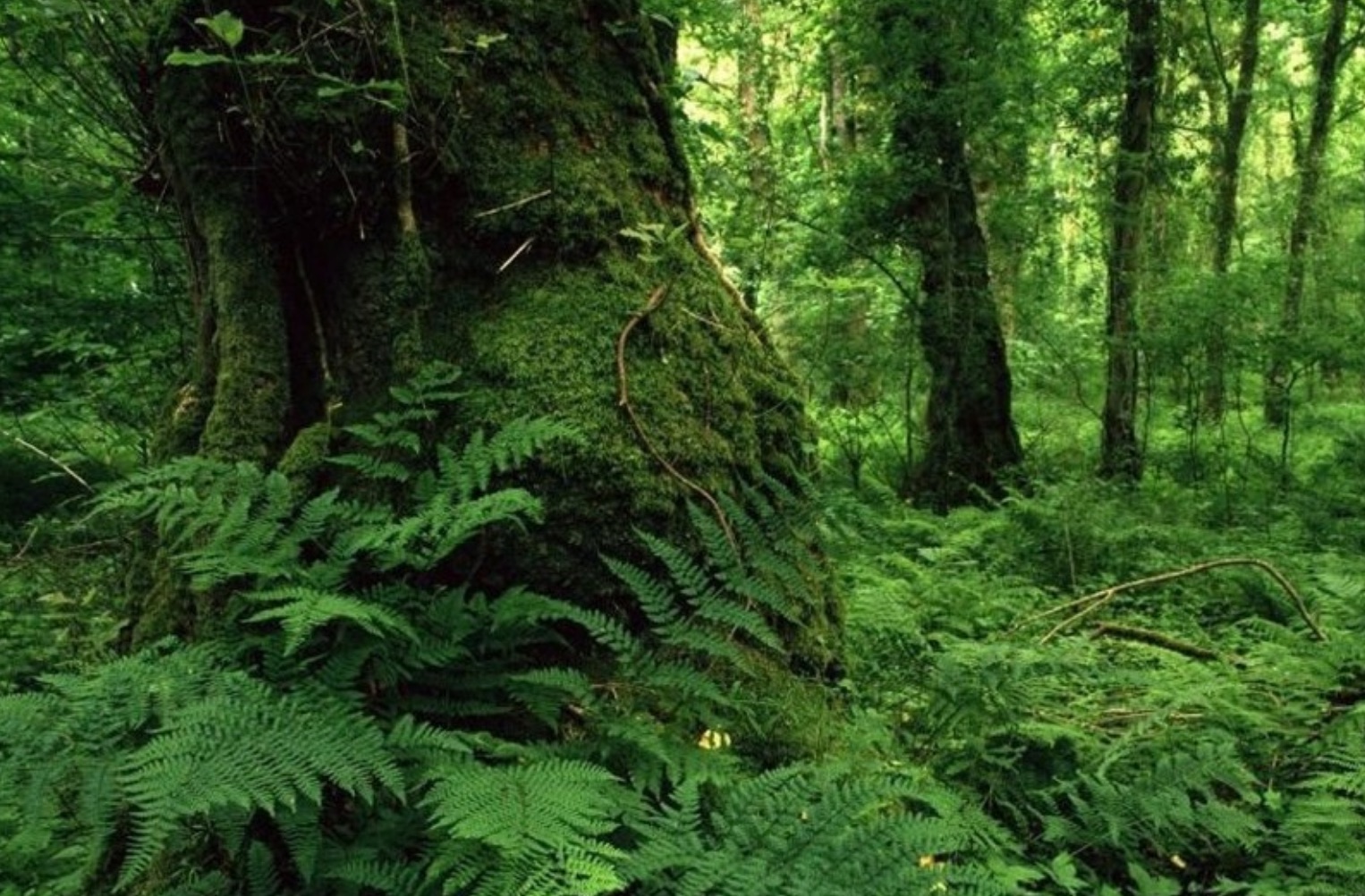
The Hyrcanian forests of northern Iran (Source: Destination Iran).
Regardless, the Greeks turned Sakarta into Zadrakarta. Many believe that Gorgan was founded by Gorgeen Milad, a hero mentioned in Ferdowsi’s Shahnameh. I have wondered about the connection between “Zad” in Zadrakarta and “Milad.” Zad in Persian means “birth” as does “milad,” albeit the latter is an Arabic word. Could the name of Ferdowsi’s hero (Milad) been a translation from Zad preserved by the Greek writers as Zadrakarta?
I also wonder about the connection between “saka” and “asagh.” This latter word was explained by the German Orientalist Wilhelm Geiger as a derivative from a series of Avestan words meaning “district” — not unlike the word “dehestan” that originated from the name of the tribe known as Daha (literally meaning “enemy” in the original Indo-Iranian lexicon), which already inhabited the areas in the southeast corner of the Caspian littoral by the time of Cyrus the Great. Could the Saka have left us their imprint in the innocuous locative suffix of “sak” or “asak” that end many of the Iranian place-names?

